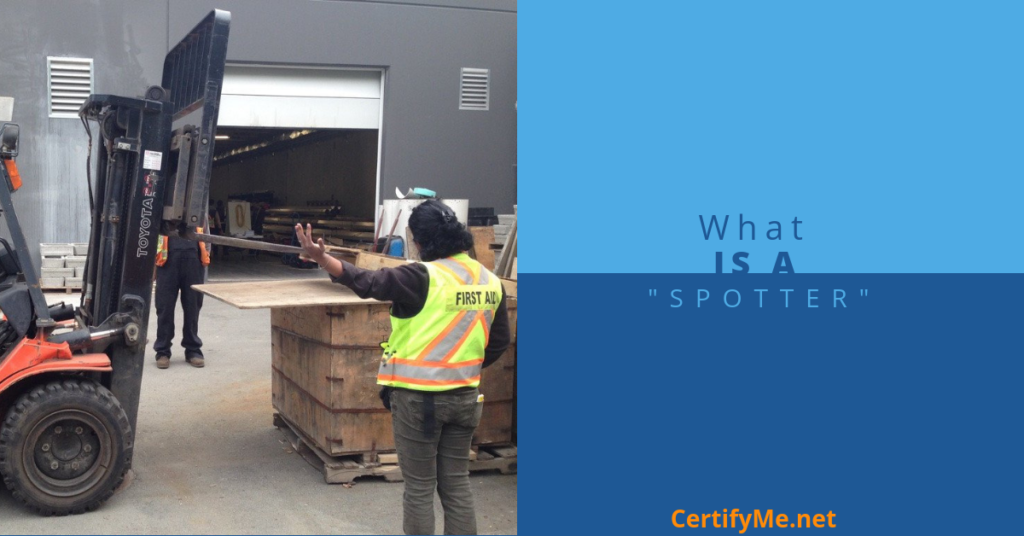Complete Guide to Forklift Spotter Training, Responsibilities, and Safety
Posted by: admin on April 15, 2025
 Visibility issues are a leading cause of forklift-related accidents in warehouses and industrial environments. Forklift spotters provide critical assistance by guiding operators safely through blind spots, obstacles, and high-risk areas. Ensuring every spotter is properly trained helps businesses reduce accident rates, boost compliance, and protect both workers and equipment.
Visibility issues are a leading cause of forklift-related accidents in warehouses and industrial environments. Forklift spotters provide critical assistance by guiding operators safely through blind spots, obstacles, and high-risk areas. Ensuring every spotter is properly trained helps businesses reduce accident rates, boost compliance, and protect both workers and equipment.
Why Forklift Spotters Are Essential
Forklifts cause thousands of injuries each year, many linked to poor visibility and communication breakdowns. Spotters help prevent collisions and tip-overs by serving as the operator’s eyes and ears in crowded or hazardous environments. OSHA emphasizes using trained spotters to minimize the risk of workplace incidents, particularly when operators navigate tight spaces or carry obstructed loads.
What Is a Forklift Spotter?
A forklift spotter is responsible for guiding a forklift operator safely through tasks that limit direct visibility. Spotters communicate using hand signals or two-way radios to help drivers maneuver loads, avoid obstacles, and stay aware of overhead hazards. Industries that use spotters regularly include warehousing, construction, shipping, and manufacturing.
Forklift Spotter Responsibilities and Duties
- Direct Travel Routes and Obstacle Avoidance: Guide operators around barriers and through narrow pathways.
- Load Lifting and Lowering Assistance: Help drivers lift, position, and lower loads safely without endangering bystanders.
- Monitor Overhead Hazards and Pedestrian Traffic: Alert forklift drivers to hanging wires, ceiling obstructions, and foot traffic.
- Maintain Clear Communication: Ensure drivers understand all hand signals or radio instructions before starting a task.
Forklift Spotter Training Requirements
While OSHA does not certify spotters separately, training is required to ensure workplace safety. Forklift spotter training typically covers:
- Spotting Techniques: Proper signaling, load awareness, and pedestrian management.
- Forklift Fundamentals: Basic understanding of forklift functions, limitations, and hazards.
- Communication Methods: Use of hand signals, radios, and standard OSHA-recommended commands.
Comprehensive forklift spotter training ensures clear communication, quick decision-making, and risk mitigation.
Forklift Spotter Safety Best Practices
- Agree on Signals Before Work Begins: Finalize visual and verbal communication standards to prevent confusion.
- Maintain Constant Visual Contact: Position yourself where the operator can see you without compromising your own safety.
- Use Radios When Necessary: Employ two-way radios when visual contact is impossible.
- Stay Clear of Forklift Blind Spots: Always position yourself out of potential reverse travel paths.
Forklift Spotting Risks and How to Mitigate Them
Spotters face hazards, particularly from backover incidents. Mitigating these risks requires:
- Active Communication: Constant updates on surroundings, load stability, and pedestrian proximity.
- Environment Scanning: Continuously monitor ground conditions, overhead clearances, and changing traffic patterns.
- Immediate Hazard Reporting: Inform operators immediately about any unsafe conditions detected during the operation.
FAQs About Forklift Spotters
Is Forklift Spotter Training Required by OSHA?
Yes. OSHA requires employers to train all workers assigned to spotting duties to ensure they understand risks and proper procedures.
Can Anyone Become a Forklift Spotter?
Workers must receive adequate training and demonstrate understanding of spotter duties and safety principles before assuming the role.
What Certifications Help Forklift Spotters Perform Better?
Training programs covering forklift operation basics, hazard recognition, and OSHA signaling standards strengthen spotters’ effectiveness.
Train Safer Forklift Spotters with CertifyMe
CertifyMe delivers OSHA-compliant forklift training that covers both operation and spotting roles. Our flexible online courses teach workers essential spotting techniques, safety protocols, and forklift fundamentals. Equip your team with the knowledge they need for safer operations—get started with CertifyMe today and build a culture of communication and safety.
Welcome to CertifyMe.net
CertifyMe.net has offered online forklift certification since 1999. With Our Convenient online program. your employess can earn their certification in an hour or less.
Browse Online Certifications:
This low-cost program can be compeleted anytime, anywhere!






